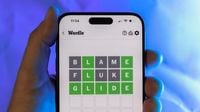For Wordle enthusiasts facing the daily challenge of deducing a secret five-letter word, June 6, 2025, brought a particularly intriguing puzzle: Wordle #1448. The answer, "EDIFY," captivated players with its meaning and structure, offering a satisfying conclusion to the day’s game.
Wordle, a deceptively simple yet addictive word game, has come a long way since its inception. Created by software engineer Josh Wardle in 2021 as a personal gift for his partner, the game quickly gained public attention. Its viral success was fueled by the unique feature allowing players to share their progress through emoji-based grids without spoiling the answer. In January 2022, The New York Times acquired Wordle for a seven-figure sum, cementing its place as a staple of online word puzzles.
Players are given six attempts to guess the secret word, each guess providing feedback through color-coded tiles: green for correct letters in the right spot, yellow for correct letters in the wrong spot, and gray for letters not in the word at all. This simple mechanic encourages strategic thinking and vocabulary knowledge, keeping millions hooked daily.
On June 6, 2025, the Wordle answer “EDIFY” presented a moderate challenge. With no repeated letters and containing two vowels—E and I—the word starts with a vowel and ends with a consonant Y, which sometimes acts as a vowel. The term means “to instruct in such a way as to improve, enlighten, or uplift morally, spiritually, or intellectually,” aligning well with the hint that this word embodies what TED Talks aim to do.
Hints offered throughout the day helped players inch closer to the answer. Early clues included the presence of two vowels and the word’s association with improvement and instruction. Additional guidance revealed the first letter was E, and there were no double letters. For those struggling, the word’s definition was a beacon: more than just educate, it’s meant to enlighten.
Competitive Wordle players also faced a “2XP Friday” on June 6, doubling their points—whether positive or negative. One commentator shared their journey, starting with guesses like “CHAIR,” “SLOPE,” and “DEIGN,” before finally landing on “EDIFY” to claim victory. Despite the challenge, the New York Times’ Wordle Bot outperformed many, solving the puzzle in three guesses and scoring points accordingly.
Strategic advice abounded across various platforms. Experts recommended starting with words containing a mix of common consonants and vowels, such as “CRANE,” “ADIEU,” “STARE,” or “ROAST.” For June 6, “FIELD” was suggested as a strong opening guess, turning four letters yellow and narrowing possibilities swiftly. Players were reminded to watch for letters appearing more than once and to approach the game like a casual crossword—taking breaks when stuck to preserve their win streaks.
Wordle’s enduring appeal lies not just in its gameplay but in its community and evolving features. Subscribers to New York Times Games enjoy perks like access to an archive of over 1,400 past puzzles and the Wordle Bot, which analyzes individual performances. Hard Mode, introduced on the official site, requires players to use all revealed letters in subsequent guesses, upping the difficulty. For the truly dedicated, Ultra-Hard Mode demands every guess be a plausible answer, adhering strictly to all clues.
Beyond Wordle, numerous spin-offs have emerged, expanding the daily puzzle concept into new territories. Games like Worldle challenge players to guess countries by their shapes, Moviedle tests movie knowledge, and Quordle multiplies the challenge by requiring the solution of four Wordles simultaneously.
Interestingly, The New York Times has been mindful about the words selected as answers. They avoid politically sensitive or potentially offensive terms, as seen when the word “FETUS” was replaced with “SHINE” in response to the Roe v. Wade developments. This care ensures the game remains inclusive and enjoyable for a broad audience.
Sharing results has become a social ritual for many players. Wordle’s built-in spoiler-free sharing feature allows users to post their colored grid without revealing the answer, fostering friendly competition and camaraderie. This aspect played a significant role in the game’s viral spread and continues to be a beloved feature.
Reflecting on the etymology of “EDIFY” adds a layer of appreciation. Derived from the Latin “aedificāre,” meaning “to build,” it journeyed through Late Latin and Old French before settling into Middle English with its current moral and intellectual connotations. It’s a fitting word for a game that builds vocabulary, sharpens minds, and fosters learning.
As Wordle continues to captivate players worldwide, June 6’s “EDIFY” stands out as a word that not only challenged but also inspired. Whether you cracked it on the first try or needed all six attempts, the puzzle offered a moment of intellectual upliftment—a true testament to the game’s enduring charm.
With over 5.3 billion plays in 2024 alone, Wordle remains one of the most popular daily online games, blending simplicity with depth. For those looking to keep their streak alive or to dive into the archive, the New York Times provides a vibrant platform to test wits and enjoy the thrill of words.




